In Situ Formation of MoS2 on the Surface of CF to Improve the Tribological Properties of PUE
Abstract
:1. Introduction
2. Experimental Materials and Methods
2.1. Experimental Materials and Equipment
2.2. Preparation of PUE and Its Composites
2.2.1. Preparation of PUE
2.2.2. Preparation of MoS2/CF
2.2.3. Preparation of MoS2/CF/PUE Composites
2.3. Hardness Test
2.4. Tensile Property Test
2.5. Compression Performance Test
2.6. Tribological Performance Test
2.7. Wear Morphology Analysis
2.8. X-ray Diffraction Analysis (XRD)
2.9. Scanning Electron Microscope Analysis (SEM)
3. Results and Discussion
3.1. Microstructure Characterization of PUE/CF/MoS2 Composites
3.2. Performance of MoS2/CF/PUE Composites
3.3. Wear Mechanism of MoS2/CF/PUE Composites
4. Conclusions
Author Contributions
Funding
Institutional Review Board Statement
Informed Consent Statement
Data Availability Statement
Conflicts of Interest
References
- Liu, Z. Research and Application Analysis of High-Speed Rollers of Belt Conveyor; Shandong University of Science and Technology: Jinan, China, 2011. [Google Scholar]
- Zhang, Y. Optimized design of long distance belt conveyor roller structure. Coal Min. Mach. 2014, 3511, 173–174. [Google Scholar]
- Li, Q. Analysis of the causes of failure of belt conveyor rollers and improvement measures. Shaanxi Coal 2019, 38, 72–75. [Google Scholar]
- Wang, J.; Zhang, B. Development of conveyor belt rollers. Min. Mach. 2011, 3905, 67–69. [Google Scholar]
- Chen, M.; Gong, H.; Lu, Y.; Lv, Z.; Zhang, Y. Research progress of polyurethane prepolymer. Bonding 2020, 41, 19–22. [Google Scholar]
- Zhang, J.; Li, Y. China’s polyurethane industry elastomer market development status. Polyurethane Ind. 2019, 34, 1–5. [Google Scholar]
- Li, X.; Dai, Y.; Huang, C.; Qiu, Y.; Ma, D. Research progress of water-based polyurethane. Shandong Chem. 2018, 47, 74–75. [Google Scholar]
- Qian, X.; Wang, X.; Zhang, Y.; Zhi, J.; Cao, A. Effect of anodic oxidation treatment on the performance of PAN-based carbon fibers. Synth. Fiber Ind. 2016, 39, 5. [Google Scholar]
- Attia, N.F.; Elashery, S.E.A.; Zakria, A.M.; Eltaweil, A.S.; Oh, H. Recent advances in graphene sheets as new generation of flame retardant materials. Mater. Sci. Eng. B 2021, 274, 115460. [Google Scholar] [CrossRef]
- Yao, S.-S.; Jin, F.-L.; Rhee, K.Y.; Hui, D.; Park, S.-J. Recent advances in carbon-fiber-reinforced thermoplastic composites: A review. Compos. Part B Eng. 2018, 142, 241–250. [Google Scholar] [CrossRef]
- Yourdkhani, M.; Liu, W.; Baril-Gosselin, S.; Robitaille, F.; Hubert, P. Carbon nanotube-reinforced carbon fibre-epoxy composites manufactured by resin fil infusion. Compos. Sci. Technol. 2018, 166, 169–175. [Google Scholar] [CrossRef]
- Alam, P.; Mamalis, D.; Robert, C.; Floreani, C.; Brádaigh, C.M. The fatigue of carbon fibre reinforced plastics: A review. Compos. Part B Eng. 2019, 166, 555–579. [Google Scholar] [CrossRef]
- Fu, S.; Shen, H. Carbon Fiber Materials Overview. J. Tonghua Norm. Univ. 2012, 33, 21–22. [Google Scholar]
- Qian, B.; Zhu, J. Carbon Fiber Development Status and Market Analysis. Synth. Fiber 2007, 7, 10–14. [Google Scholar]
- Xie, F.; Feng, X. Analysis and exploration of the current situation and market of carbon fiber development. Priv. Technol. 2016, 11, 88. [Google Scholar] [CrossRef]
- Huang, C.; Chen, G.; Wang, Q.; Wang, Z.; Yu, Q.; Liu, X. Advances in carbon fiber surface modification technology. Eng. Plast. Appl. 2022, 50, 170–174. [Google Scholar]
- Wen, X.; Fu, K.; Dou, Y.; Xia, X.; Zhang, J. Stiffness and Frequency Response Characteristics of Glass Fiber Reinforced Plastic Wave Springs with Different Periods and Its Finite Element Analysis. Materials 2022, 15, 9045. [Google Scholar] [CrossRef]
- Dong, G.; Ding, Y.; Yang, W.; Xie, P. Combined ultrasonic-hydrogen peroxide oxidation treatment of continuous carbon fiber surfaces. J. Beijing Univ. Chem. Technol. (Nat. Sci. Ed.) 2017, 44, 45–49. [Google Scholar]
- Li, Y.; Qiao, Y.; Fan, X.; Fei, Y. Microwave-induced oxidation treatment of carbon fiber surfaces. Plast. Ind. 2016, 44, 71–75. [Google Scholar]
- Zhou, K.; Liu, J.; Zeng, W.; Hu, Y.; Gui, Z. In situ synthesis, morphology, and fundamental properties of polymer/MoS2 nanocomposites. Compos. Sci. Technol. 2015, 107, 120–128. [Google Scholar] [CrossRef]
- Yan, C.; Fu, H. Progress of WPU modification research. Chem. Prog. 2011, 30, 2658–2664. [Google Scholar]
- Zhou, K.; Gao, R.; Qian, X. Self-assembly of exfoliated molybdenum disulfide(MoS2) nanosheets andlayered double hydroxide(LDH): Towards reducing fire hazards of epoxy. J. Hazard. Mater. 2017, 338, 343–355. [Google Scholar] [CrossRef] [PubMed]
- Zhang, J.; Jiang, G.; Huang, T.; Yu, W.; Gao, Y. Synthesis and performance of polyurethane/silicon oxide nano-composite coatings. Sci. Eng. Compos. Mater. 2019, 26, 301–307. [Google Scholar] [CrossRef]
- Feng, C.; Guo, Y.; Yu, Z.; Chen, K.; Wang, D.; Li, X.; Luo, Y.; Wang, Q.; Zhang, D. Tribological Properties of PEEK Composites Reinforced by MoS2 Modified Carbon Fiber and Nano SiO2. Tribol. Int. 2023, 181, 108315. [Google Scholar] [CrossRef]

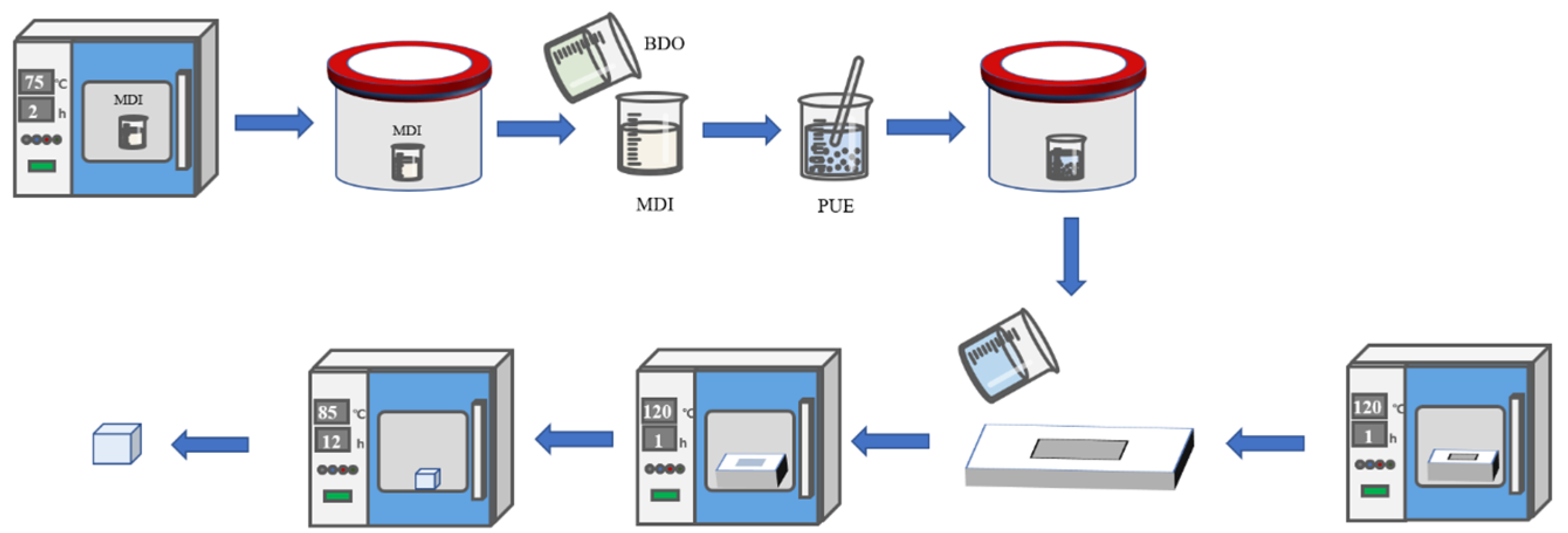


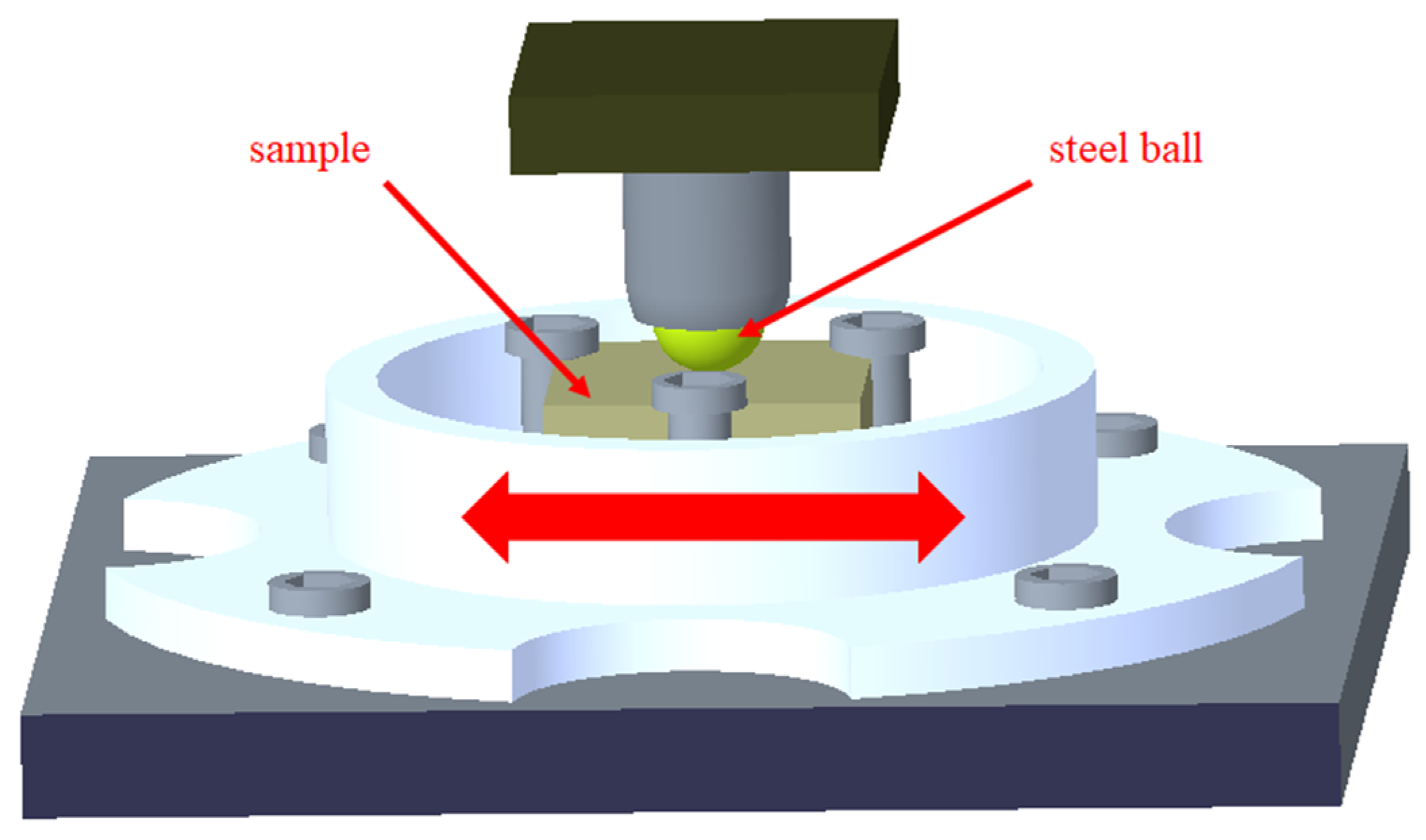
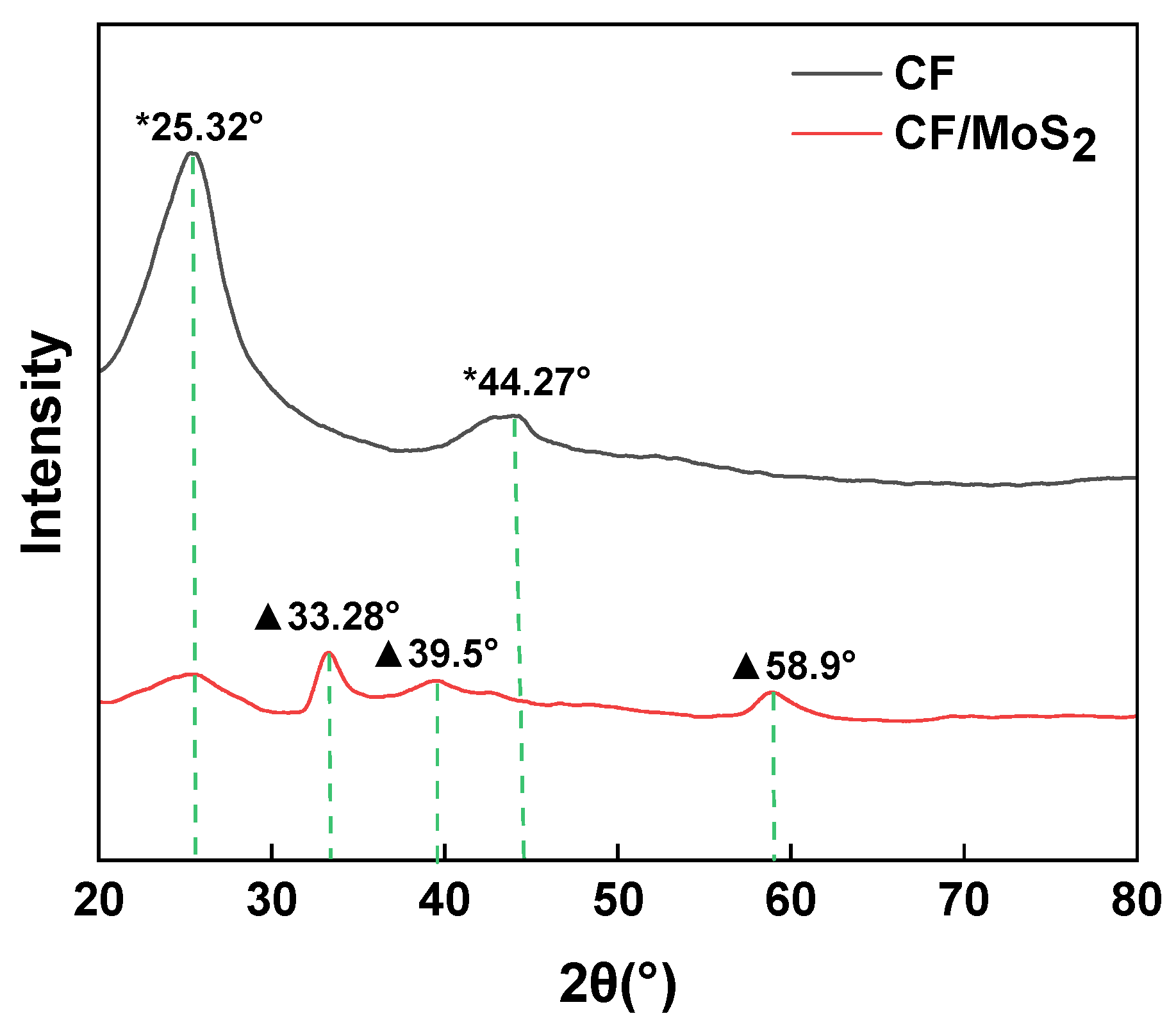

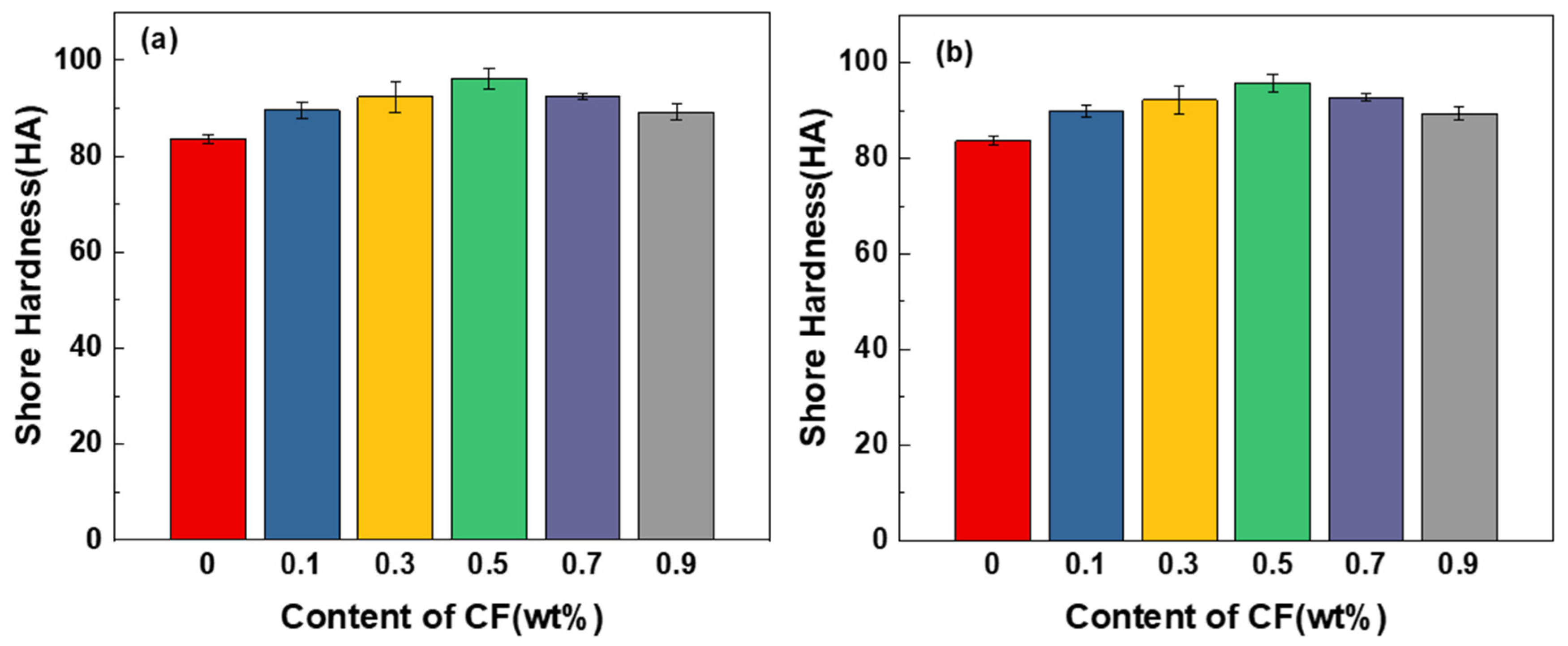

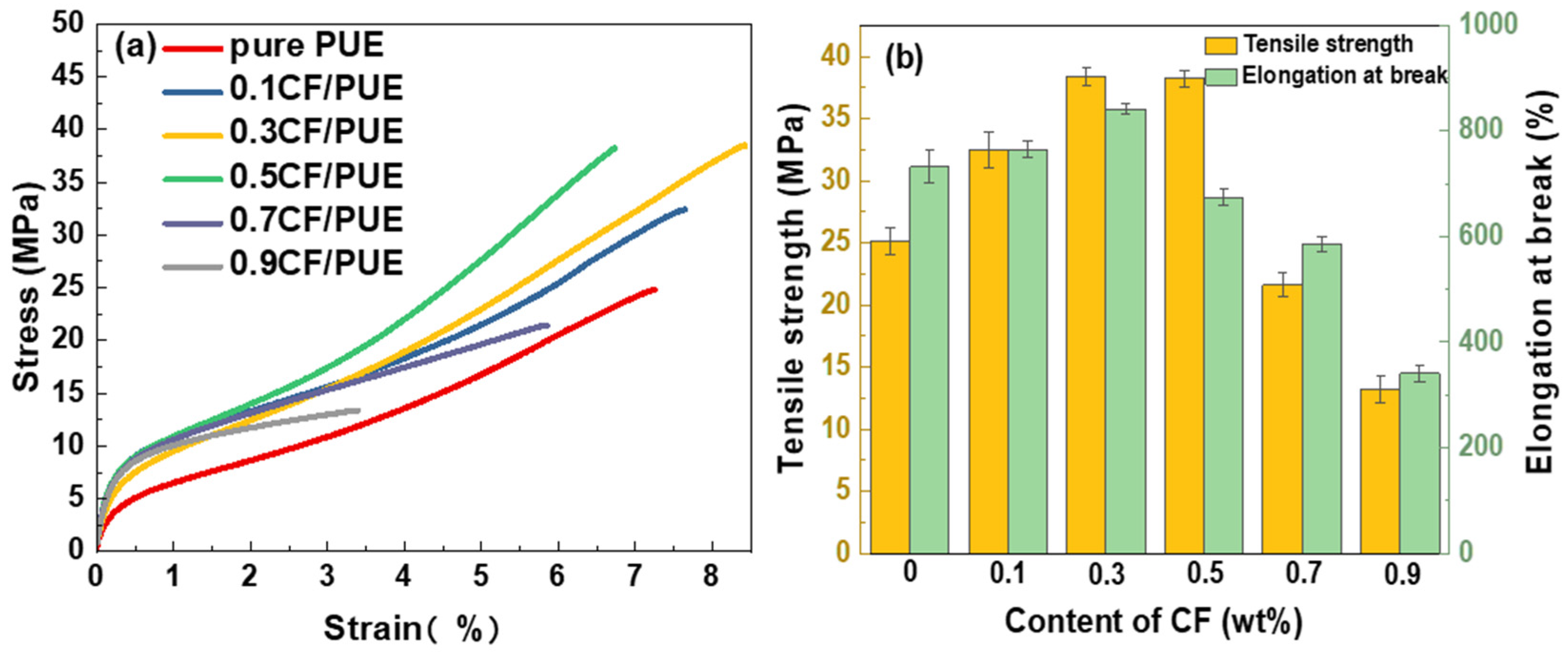



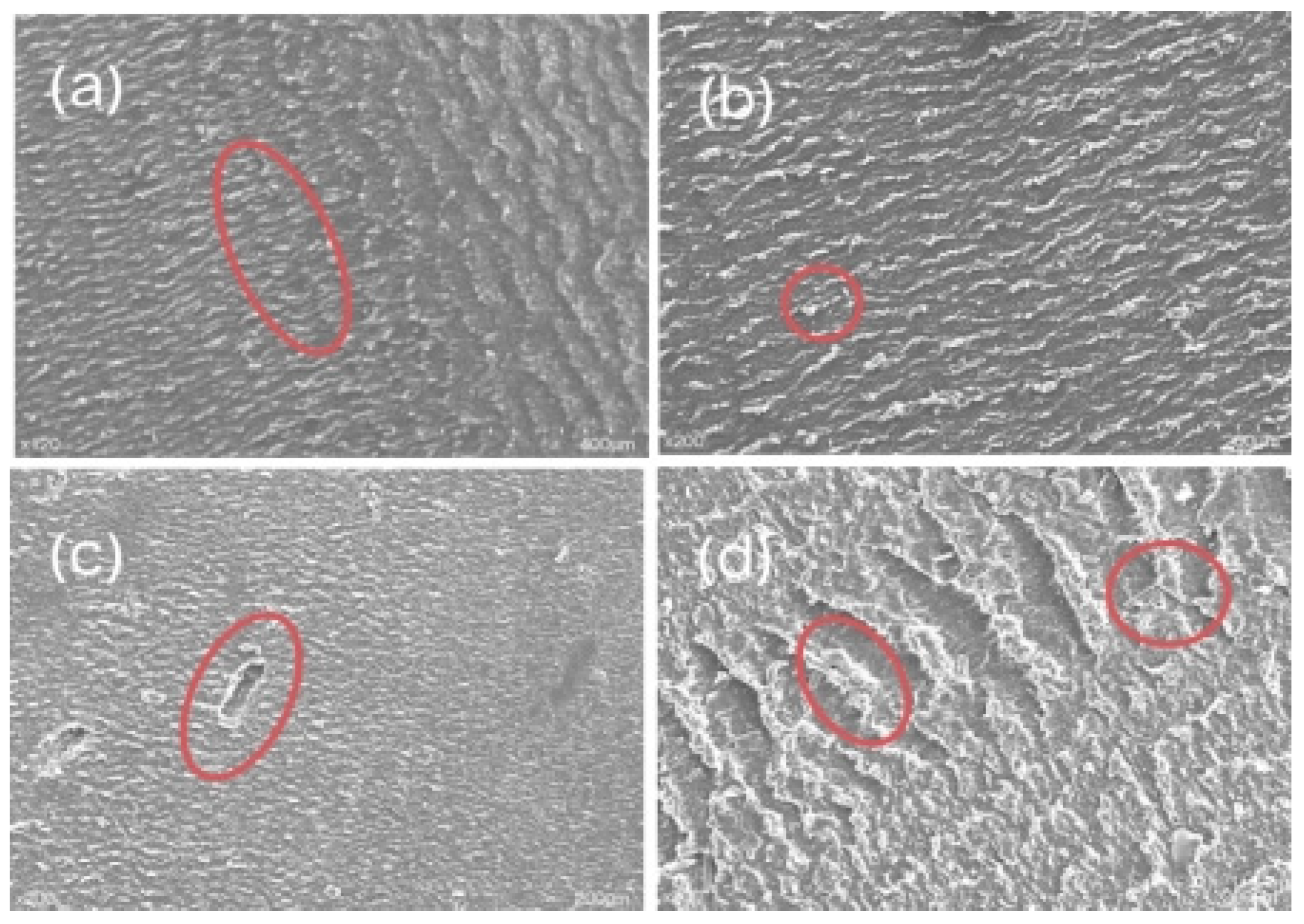


| Experimental Materials and Equipment | Producer |
|---|---|
| MDI prepolymer | Shanghai Hecheng Polymer Technology Co., Ltd. CHN city, country |
| 1,4 butanediol (BDO) | Guangdong Yuemei Chemical Co., Ltd. CHN |
| Carbon fiber | Hangzhou Gaoke composite material Co., Ltd. CHN |
| Thiourea (CH4N2S) | Aladdin reagent (Shanghai) Co., Ltd. CHN |
| Molybdic acid (H8MoN2O4) | Aladdin reagent (Shanghai) Co., Ltd. CHN |
| Nitric acid | Aladdin reagent (Shanghai) Co., Ltd. CHN |
| Absolute ethanol | Xilong Chemical Co., Ltd. ShanTou, CHN |
| Electronic balance: ZA2054AS | Shanghai Zanwei weighing instrument Co., Ltd. CHN |
| Ultrasonic cleaning machine: KQ2200E | Kunshan Ultrasonic Instrument Co., Ltd. CHN |
| Blast drying oven: XGQ-200 | Yuyao Xingchen Instrument Factory, CHN |
| Vacuum pump: XP135 | Dingsheng Vacuum Equipment Co., Ltd. CHN |
| Vacuum tank: XP135 | Dingsheng Vacuum Equipment Co., Ltd. CHN |
| Digital display electric mixer: JJ-1A 100W | Fangke instrument (Changzhou) Co., Ltd. CHN |
| Friction and wear tester: UMT-3 | Beijing Yicheng Hengda Technology Co., Ltd. CHN |
| Universal tensile tester: PT-307, | Dongguan pusaite testing equipment Co., Ltd. CHN |
| High-speed camera: VW-9000, | Keans (China) Co., Ltd. |
| Shore hardness tester: type A, | Yangzhou process test Machinery Co., Ltd. CHN |
| D8ADVANCE X-ray diffractometer | Bruker AG, Germany |
| G-301 scanning electron microscope | Hitachi, Ltd. JP |
Disclaimer/Publisher’s Note: The statements, opinions and data contained in all publications are solely those of the individual author(s) and contributor(s) and not of MDPI and/or the editor(s). MDPI and/or the editor(s) disclaim responsibility for any injury to people or property resulting from any ideas, methods, instructions or products referred to in the content. |
© 2023 by the authors. Licensee MDPI, Basel, Switzerland. This article is an open access article distributed under the terms and conditions of the Creative Commons Attribution (CC BY) license (https://creativecommons.org/licenses/by/4.0/).
Share and Cite
Feng, C.; Guo, Y.; Li, X.; Cao, Y.; Kuang, Q.; Zhang, M.; Zhang, D. In Situ Formation of MoS2 on the Surface of CF to Improve the Tribological Properties of PUE. Materials 2023, 16, 5773. https://doi.org/10.3390/ma16175773
Feng C, Guo Y, Li X, Cao Y, Kuang Q, Zhang M, Zhang D. In Situ Formation of MoS2 on the Surface of CF to Improve the Tribological Properties of PUE. Materials. 2023; 16(17):5773. https://doi.org/10.3390/ma16175773
Chicago/Turabian StyleFeng, Cunao, Yu Guo, Xiaowei Li, Yang Cao, Qiuxue Kuang, Minghui Zhang, and Dekun Zhang. 2023. "In Situ Formation of MoS2 on the Surface of CF to Improve the Tribological Properties of PUE" Materials 16, no. 17: 5773. https://doi.org/10.3390/ma16175773





